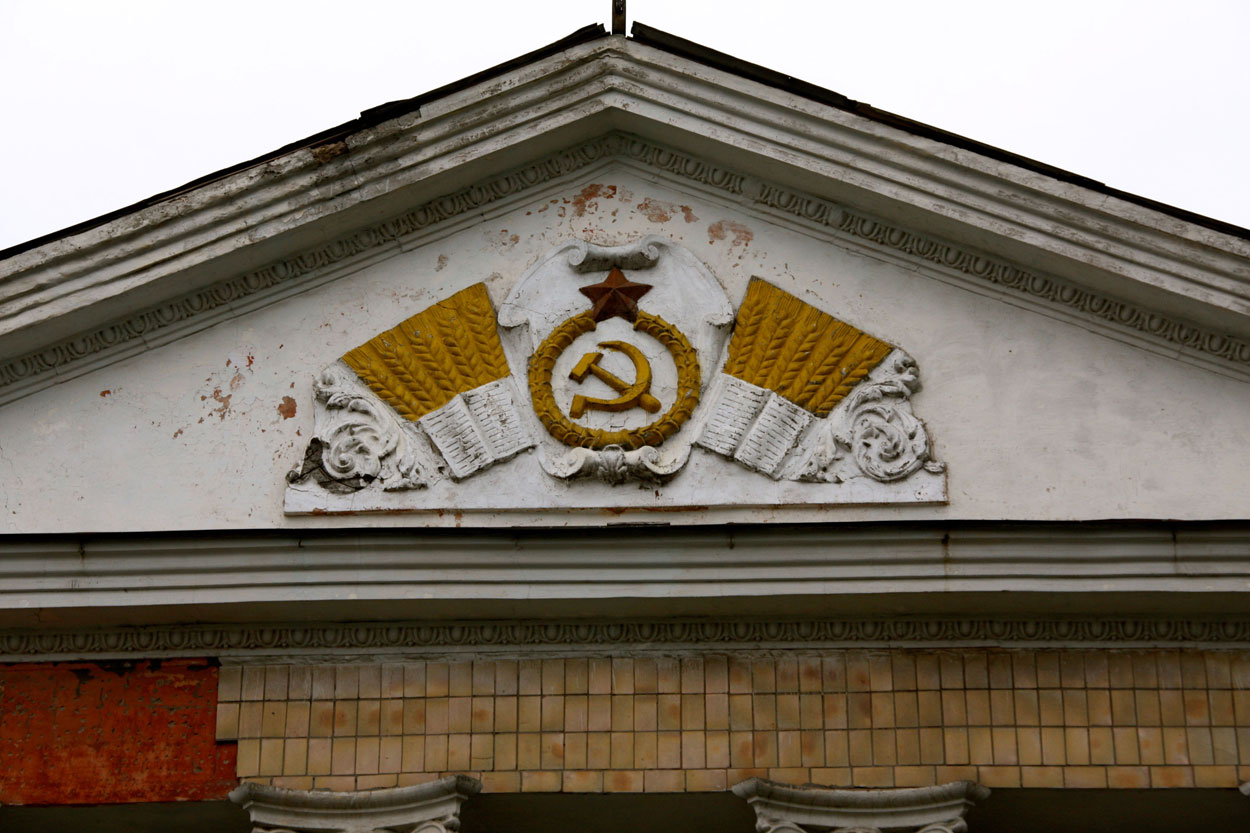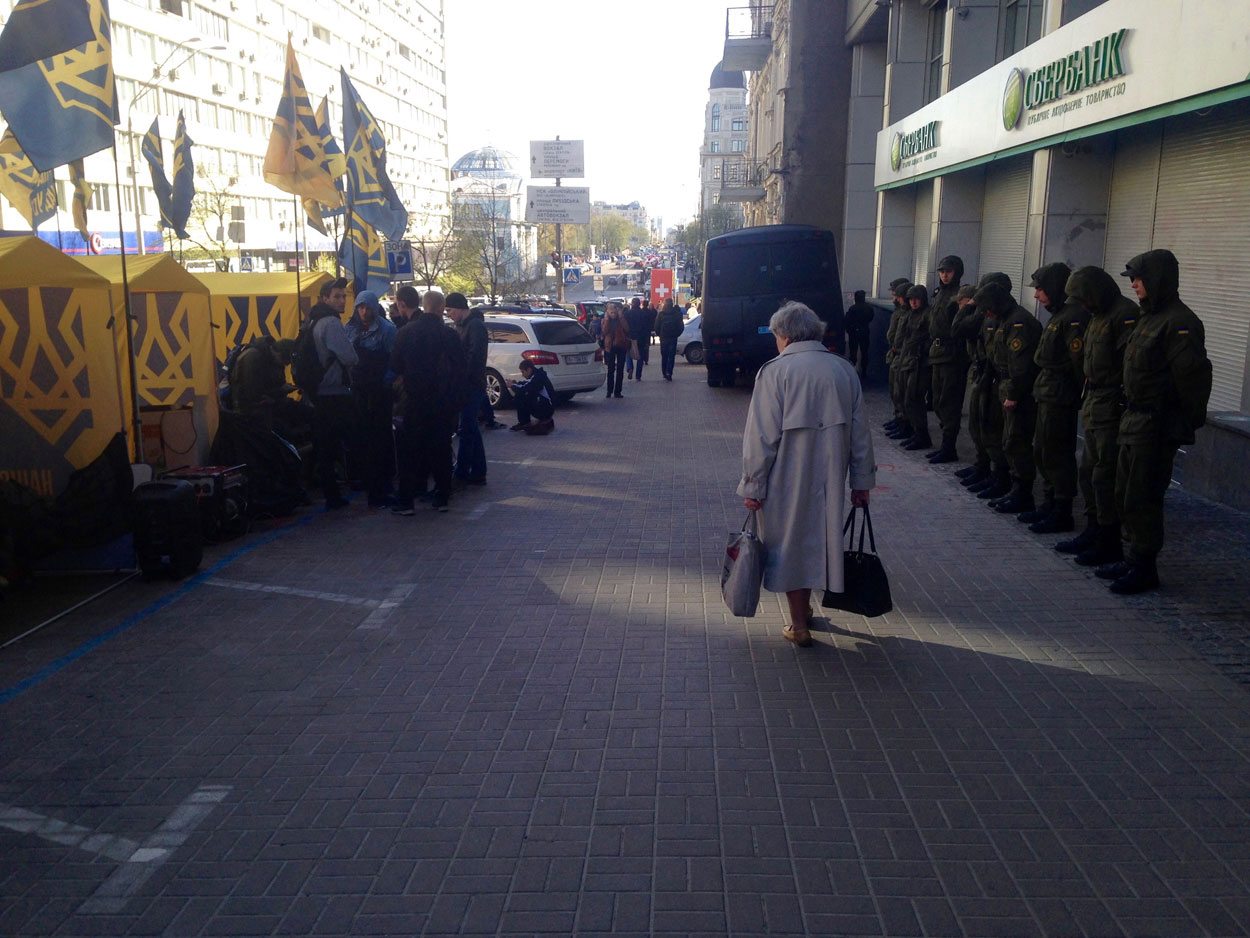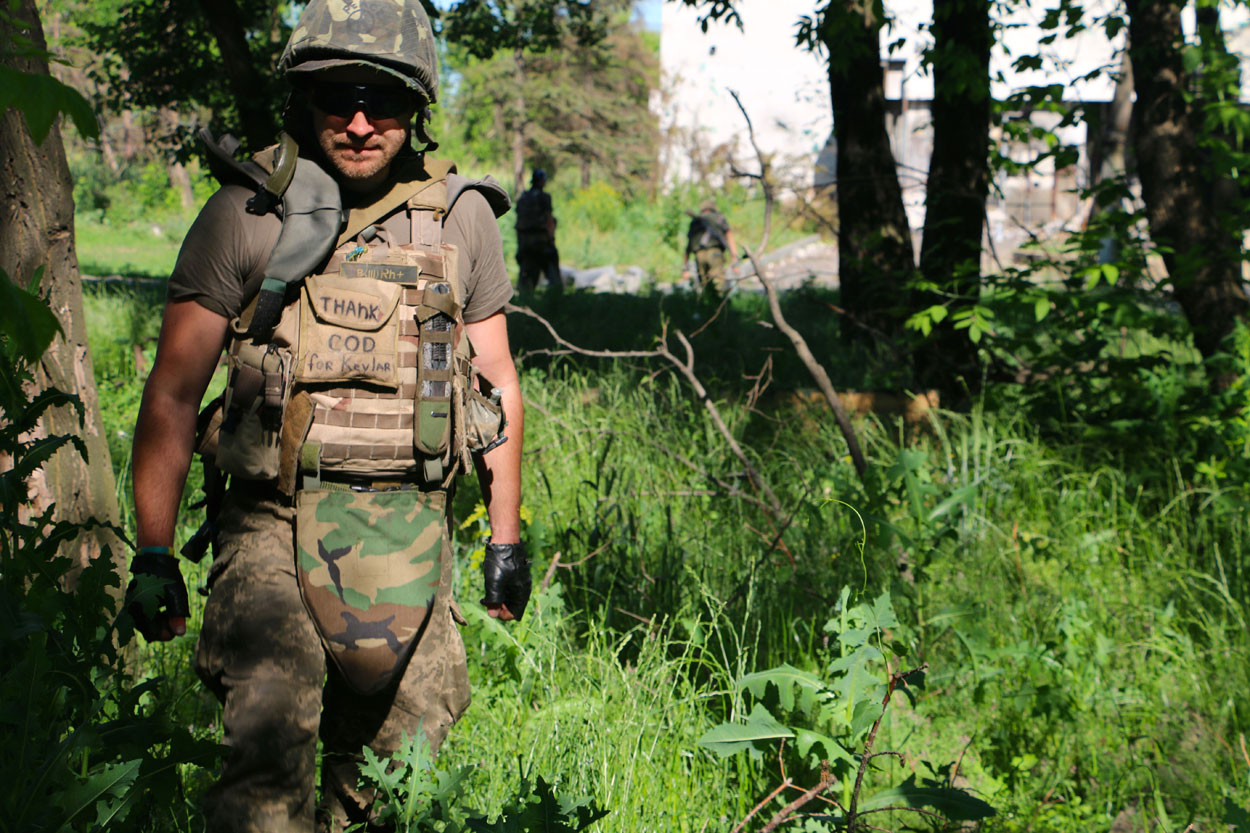KYIV, Ukraine—On Wednesday, Russian weapons killed three Ukrainian troops and wounded five more in eastern Ukraine’s embattled eastern Donbas region, where Moscow continues to wage a 4-year-old proxy war, which has, so far, killed more than 10,300 Ukrainians.
Meanwhile, grocery stores in Kyiv are still stocked with Russian products, such as caviar and vodka, and Russian food chains are still open throughout the city. From Kyiv’s central train station, you can still travel to Moscow.
Last year, Russia’s proxy war in eastern Ukraine became markedly more violent. Even so, bilateral trade between Russia and Ukraine grew by nearly a third, underscoring a complicated spider’s web of geopolitical and economic interests that still bind the two erstwhile Soviet allies, even while they maintain a de facto state of war with one another.
“These trade patterns do not disappear suddenly—not even when both countries are at war,” Marcel Van Herpen, director of the Cicero Foundation, a Dutch think tank that focuses on European affairs, told The Daily Signal.
Despite a February 2015 cease-fire, known as Minsk II, the war in eastern Ukraine is ongoing—artillery exchanges and small arms battles still occur daily. Moscow, for its part, continues to feed the conflict with weapons, cash, and its own troops.
In 2017, the conflict’s overall number of cease-fire violations increased by 25 percent over the previous year, international monitors said, underscoring an overall increase in violence in which, on average, one Ukrainian soldier dies in combat every three days.
Meanwhile, bilateral trade between Russia and Ukraine went up by 29 percent through November of last year, the National Bank of Ukraine reported. That trade jump included a 38.6 percent increase in imports from Russia alongside an 11.6 percent rise in Ukrainian exports to a country Ukraine’s parliament has officially labeled as the “aggressor nation.”
The Ukrainian State Statistics Service had a slightly lower—yet still substantial—estimate of the growth rate in Russo-Ukrainian trade through November, putting that number at about 26 percent—which, incidentally, is the same rate at which Ukraine’s trade increased with the European Union in the same period.
Imports from Russia totaled $5.5 billion through November 2017, the Ukrainian State Statistics Service reported.
“I do not find the slight increase in Ukrainian-Russian trade all that surprising,” Luke Coffey, director of The Heritage Foundation’s Foreign Policy Studies Center, told The Daily Signal.
“Now that the war has entered its fourth year and the front lines remain stable, local trading arrangements between the two countries that have been around for years are probably starting to tick over again,” Coffey said.
‘A Step Backward’
Across the board, Ukrainian trade went up by about 24 percent through October of last year, officials said.
Still, it has caught some by surprise that Ukraine’s trade with Russia would grow at the same rate as with the European Union—while the country fights a war to ostensibly divest itself from Russia’s sphere of influence in favor of a pro-Western future.
“From my point of view, it’s a step backward for Ukraine,” Andrii Telizhenko, a Kyiv-based political and security consultant, told The Daily Signal.
Telizhenko, who worked as a political officer at Ukraine’s U.S. Embassy, said the Ukrainian government is to blame for stifling Ukraine’s competitiveness in the European market, spurring some businesses to revert back to selling their goods in Russia and other post-Soviet states.

An anti-Russian protester outside Ukraine’s parliament building in Kyiv in 2015. (Photo: Nolan Peterson/The Daily Signal)
“Neither the government of Ukraine nor the oligarchs personally understand international politics and economics in depth,” Telizhenko said. “For them it is easier to make a deal on the side and with markets they understand the mentality of, rather to invest more into business and trade so that Ukrainian products are more competitive and wanted in the EU and the West.”
Ukraine’s ongoing trade relationship with Russia is a particularly bitter pill to swallow for both Ukraine’s combat veterans and its active-duty soldiers still on the front lines, enduring a fourth Continental winter in the trenches under daily Russian artillery fire.
“Ukraine should not trade with the aggressor, even if it is bad for the economy,” 29-year-old Ukrainian combat veteran Mikhail Prytula told The Daily Signal.
Prytula, a volunteer soldier, spent one year on the front lines in the Donbas.
Mixed Signals
For his part, Russian President Vladimir Putin heralded last year’s trade growth between Russia and Ukraine.
“This is a good sign that we have fundamental resources for restoring the relations in general,” Putin reportedly told reporters in Moscow on Jan. 11.
“I expect that after issues in Donbas have been resolved—this will happen sooner or later, there are no doubts about that—interstate relations between Russia and Ukraine will be normalizing as a whole,” the Russian president added.
However, many outside experts as well as current and former Ukrainian officials say last year’s boost in Russo-Ukrainian bilateral trade is not a true bellwether for peace.
Nataliya Mykolska, trade representative of Ukraine, said it’s simply about the bottom line.
“The trade turnover growth means two things. Russia has goods in its market needed in Ukraine and vice versa,” Mykolska said Dec. 29, according to Ukrainian news reports. “Business will always buy what is more profitable to it, and what it can buy at the lowest price with the best supply conditions.”
Despite the trade growth, Ukrainian lawmakers have not let up on their rhetorical retort to Russian military aggression. On Thursday, Ukraine’s parliament—the Verkhovna Rada—passed a law banning Russians from making bids on privatized state property.
The ban singles out the Russian Federation as the “aggressor state.”
Moreover, on Thursday, the National Security and Defense Council of Ukraine, or NSDC, endorsed a draft national security law explicitly identifying Russia as Ukraine’s top security threat.
NSDC Secretary Oleksandr Turchynov called the draft law “an important element in safeguarding Ukrainian statehood and counteracting Russian aggression.”
Yet, even with the rhetorical drumbeat against Russia coming from Kyiv, some say that reverting back to Russian trade markets is the path of least resistance for Ukrainian political and business leaders stuck in old economic habits, dating from a time in the post-Soviet era when Ukraine was still a de facto vassal state of Russia’s.
“Ukraine’s old trade dependence from Russia still exists in the heads of the economic actors, who still need to adapt to the new situation,” Van Herpen said, adding that many of Ukraine’s oligarchs retain close business ties to Russia.
Conversely, another line of thinking is that Ukraine has a much more diverse trade portfolio than it did pre-2014—including big boosts in trade with the EU, Canada, and China in particular—and Russia no longer has the exclusive stranglehold over Ukraine’s economy that it once exploited to bend Kyiv to its will.
With that in mind, some say, Ukraine is now able to rekindle some of its lost Russian trade with the confidence that Russia won’t gain back its previous economic leverage.
Still, renewing trade with Russia is a risky proposition, others argue, despite Ukraine’s newly broadened trade market.
Along these lines, Van Herpen said one factor contributing to the growth in Russo-Ukrainian trade is “the passivity of the Ukrainian government, which seems to be satisfied that the overall trade volume [with Russia] has diminished over the last years and that trade with the EU is growing since the free trade agreement with the EU bloc.”
“However,” Van Herpen added, “this passivity could be dangerous … An increase in hostilities in the Donbas should at least be answered with economic sanctions.”
Come Undone
As far as individual countries go (not counting the EU, an economic bloc) Russia is still Ukraine’s top trading partner.
However, despite last year’s growth, trade between Russia and Ukraine is still a fraction of what it was before the war. And while some Russian food chains are still open for business in Kyiv, others have failed in the past two years, including Yakitoria, and the Russian franchising company Rosinter’s TGI Fridays and IL Patio restaurants.
Ukraine imported about $24.65 billion worth of Russian goods in 2013, the year prior to its pro-Western revolution and the beginning of hostilities with Russia.
By 2016, that number was down to $5.65 billion—23 percent of its pre-war value.
Ukraine’s exports to Russia have also taken a hit.

Ukraine’s economic ties to Russia date back to the Soviet era. (Photo: Nolan Peterson/The Daily Signal)
In 2013, 23 percent of Ukraine’s exports went to Russia, comprising some $15 billion worth of goods.
By 2016, the value of Ukraine’s exports to Russia dropped to $3.6 billion, comprising 8 percent of the overall number.
In sum, the EU is now Ukraine’s largest trading partner, accounting for more than 40 percent of its trade in 2016. Still, some say Ukrainian goods are not competitive enough in the European marketplace, thereby preventing a more comprehensive trade split with Russia.
Referring to Ukrainian trade with the EU, Telizhenko said, “We do sell a lot but it’s minor products such as bolts, small engine parts—and from major products it’s ore.”
“All other major products—such as tractors, metal, engines, vehicles—are only bought by the Asian and Russian markets,” Telizhenko added. “There is no competitiveness and there is no support from the government to produce high-quality products for export due to the meddling of the oligarchs with the government, not letting business to develop.”
Frozen Conflict, Thawing Trade
With artillery attacks and small arms battles reported daily, the conflict in eastern Ukraine became more violent in 2017, even if conventional combat operations never expanded beyond the geographic limits put in place by the February 2015 Minsk II cease-fire.
Monitors from the Organization for Security and Cooperation in Europe, or OSCE, recorded 401,336 cease-fire violations in 2017, a 25 percent jump from the 320,130 in 2016.

Ukrainian combat veteran Mikhail Prytula served for one year in the eastern war zone. (Photo courtesy of Mikhail Prytula)
About 60,000 Ukrainian troops remain in trenches and forts along a 250-mile-long front line in eastern Ukraine’s embattled Donbas region opposite a combined force of about 35,500 pro-Russian separatists, foreign mercenaries, and Russian regulars.
Minsk II proscribed heavy weapons above a certain caliber within a buffer zone on either side of the contact lines. Nevertheless, OSCE monitors observed banned weapons in the war zone 4,065 times in 2017—a 31 percent increase from the 3,099 times monitors observed such weapons in 2016.
U.S. and Ukrainian officials say Russia has command and control authority over the breakaway territories in eastern Ukraine, and the war’s intensity is correspondingly dialed up or down according to the Kremlin’s pleasure.
Moscow, however, maintains it’s not involved in the war.
Baby Steps
Due to the war, Ukraine has economically unbound itself from Russia in some key areas—a painful process as the country endures the aftershocks of a sharp post-revolutionary economic downturn.
As recently as 2015, Russia supplied 95 percent of Ukraine’s nuclear fuel by value.
In December 2017, Kyiv announced that its nuclear fuel supplies are now split 50-50 between a Russia supplier and the U.S. firm Westinghouse.
Also, Ukraine has built up about a one-year nuclear fuel reserve, and can therefore make the switch over to non-Russian nuclear suppliers without a loss in energy output if Russia were to cut off its deliveries. Roughly half of Ukraine’s energy is nuclear.
Prior to 2014, Ukraine and Russia had close defense sector ties, mainly due to a Soviet strategy to geographically scatter its weapons manufacturing base as a hedge against an invasion or loss of territory.
Even so, Ukraine banned military exports to Russia after the war in the Donbas began. Since 2014, Ukraine and Russia have not signed any arms sales agreements.
China is now Ukraine’s top purchaser of military equipment, totaling $90 million in sales in 2016, and Ukrainian President Petro Poroshenko has declared his goal of moving Ukraine up into the world’s top five weapons exporting countries.
Recently, the Ukrainian aircraft manufacturer, Antonov rolled out its An-132D transport airplane—a modern revamp of a Soviet-era aircraft—produced without any Russian parts.
Still, while Ukraine has taken steps forward to divest itself from Russian trade, it has also rekindled that economic relationship in other sectors, most notably in energy.
Ukraine had weaned itself off of Russian gas, favoring supplies from the EU. But on Wednesday, Naftogaz—the national oil and gas company of Ukraine—announced it was ending a two-year boycott on the purchase of Russian gas from Gazprom.
“We plan to import gas from two directions. The price which Gazprom is now obliged to set is very attractive. We should take advantage of this economic benefit,” Naftogaz CEO Andriy Kobolyev told reporters in Kyiv Wednesday, adding that Ukraine would probably import about one-third of its natural gas from Russia in 2018.

The war in Ukraine is ongoing—so far it has killed more than 10,300 Ukrainians. (Photo: Nolan Peterson/The Daily Signal)
Transit of Russian natural gas through Ukraine’s pipelines increased by 13 percent in 2017, topping out at 93 billion cubic meters—the highest level since 2011, Naftogaz reported.
At $2.4 billion in purchases, Ukraine nearly doubled spending for coal imports in 2017, taking half from Russia, the State Fiscal Service reported. Ukraine supplied its own coal prior to 2014.
Through November 2017, about three-quarters of Ukraine’s oil imports—worth $2.8 billion—came from Russia and Belarus. Belarus is a major transit country for Russian oil.
And on Dec. 29, Ukraine lifted sanctions on a Russian coal supplier, Yuzhtrans, which is one of the largest suppliers of anthracite to Ukraine.
There are, however, some intractable limits to any rebounding Russo-Ukrainian trade. For one, Ukrainian officials have said that import duties on Russian goods—introduced in 2016 due to parallel Russian moves—will remain in place in 2018.
“Of course, Ukraine must be very careful that it does not get its trade and economic relationship too close to Moscow,” The Heritage Foundation’s Coffey said.
“This is unlikely to happen anyway,” Coffey added, “due to the anti-Russian feeling prevalent throughout the country and the fact that Ukraine’s exports and imports have been significantly diversified away from Russia toward new markets since the Russian invasion of 2014.”






























